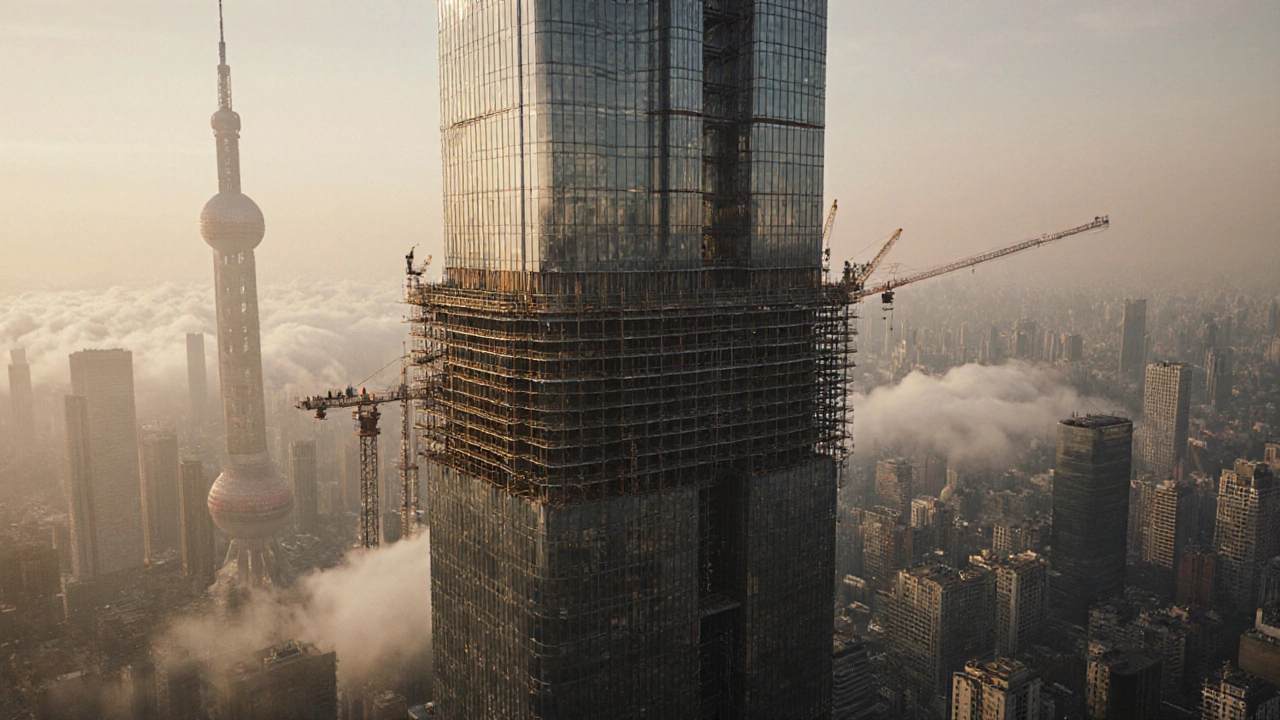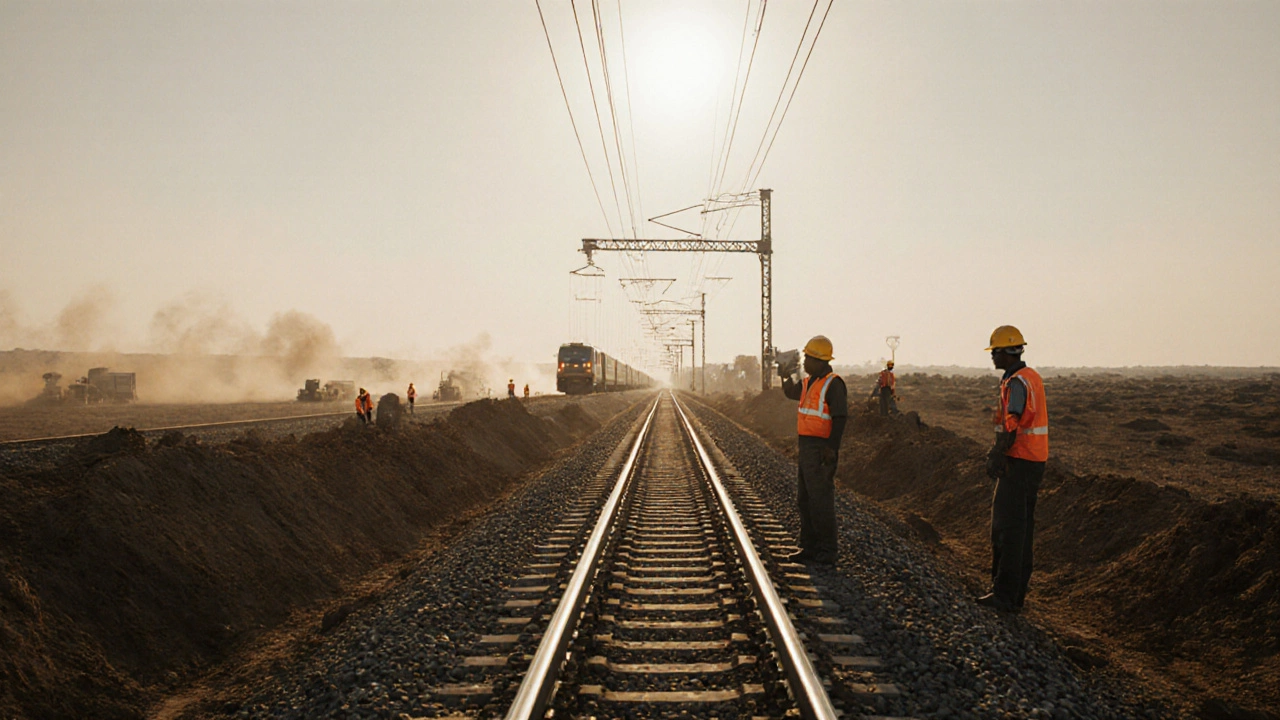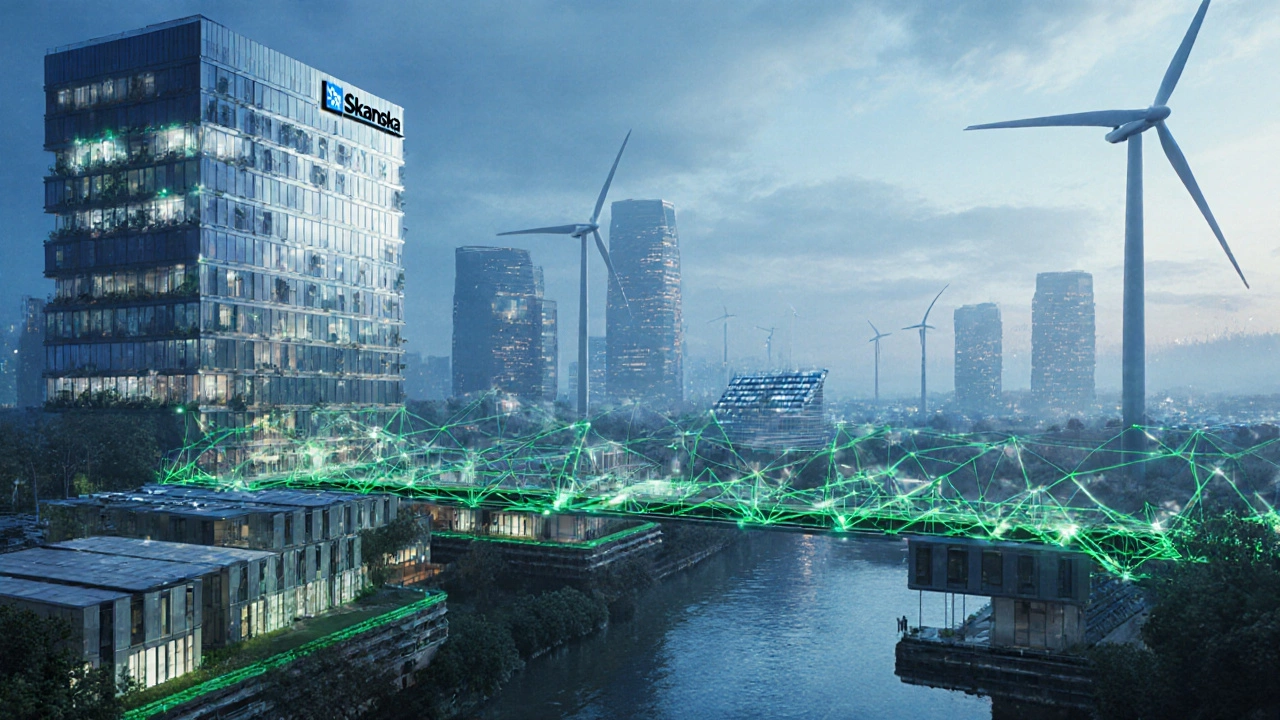Top 10 Construction Companies in the World 2025
 Nov, 10 2025
Nov, 10 2025
Global Construction Company Comparison Tool
Compare Top Construction Companies
Select up to 3 companies to compare their key metrics: revenue, specialization, sustainability, and technology adoption.
How to Choose
Consider these key differentiators when selecting a construction partner for your project:
- Specialization: Choose based on project type (rail, green buildings, energy systems)
- Geographic Reach: For international projects, select companies with experience in your region
- Sustainability: Critical for projects with environmental targets (Skanska leads here)
- Tech Adoption: For complex projects, look for companies using AI, drones, and digital twins
When you think of skyscrapers, bridges, airports, or entire cities rising from the ground, you’re not just seeing concrete and steel-you’re seeing the work of a handful of massive construction companies that move billions in projects every year. These aren’t local contractors. These are global giants that build infrastructure across continents, manage workforces larger than small countries, and shape the way the world looks and functions.
The construction industry isn’t just about building houses. It’s about power plants in Saudi Arabia, high-speed rail in Japan, hospitals in Nigeria, and subway tunnels under New York. The companies leading this are ranked by revenue, project scale, geographic reach, and technical innovation. And in 2025, the top 10 aren’t just big-they’re redefining what’s possible.
1. China State Construction Engineering Corporation (CSCEC)
China State Construction Engineering Corporation, or CSCEC, isn’t just the largest construction company in the world-it’s bigger than the next four combined. With over $500 billion in annual revenue, CSCEC operates in more than 100 countries. They built the 632-meter Shanghai Tower, the third-tallest building on Earth, and are behind half of China’s high-speed rail network. Their workforce exceeds 400,000 people. What sets them apart isn’t just size-it’s speed. They built a 57-story hospital in Wuhan in just 10 days during the pandemic. No other company on earth can match that pace at that scale.
2. China Railway Construction Corporation (CRCC)
If CSCEC builds buildings, CRCC builds the rails that connect them. With $150 billion in annual revenue, CRCC dominates global rail infrastructure. They’ve built over 40,000 kilometers of railway worldwide, including the Addis Ababa-Djibouti Railway in Africa and high-speed lines in Turkey and Indonesia. Their projects often involve complex geology and political challenges, yet they consistently deliver on time. They also handle large-scale urban transit systems, including metro expansions in Southeast Asia and the Middle East. Their specialization in rail gives them a unique edge in markets where governments are investing heavily in public transport.
3. Bechtel Corporation
Based in the U.S., Bechtel is the only non-Chinese company in the top 3. Founded in 1898, it’s one of the oldest and most respected names in global construction. Bechtel doesn’t just build-it transforms. They built the Hoover Dam, the Channel Tunnel between England and France, and the entire nuclear power infrastructure for the U.S. Navy. Today, they’re leading the charge in green energy projects: offshore wind farms in the North Sea, hydrogen production plants in Australia, and solar farms in the Middle East. Their strength lies in managing multi-billion-dollar, multi-year projects with precision. They’ve never missed a deadline on a major infrastructure project in the last 25 years.
4. China Railway Group Limited (CREC)
CREC is another Chinese powerhouse, but it focuses on large-scale civil engineering projects. With $120 billion in revenue, it’s a major player in tunnels, bridges, and dams. They built the world’s longest sea-crossing bridge-the Hong Kong-Zhuhai-Macau Bridge-and are currently working on the $100 billion Belt and Road Initiative projects across Africa and Central Asia. Unlike CSCEC, CREC doesn’t build skyscrapers. They build the hidden infrastructure that makes cities work: underground metros, flood control systems, and mountain tunnels. Their engineering teams are known for solving problems others call impossible, like building through the Himalayas or under active fault lines.
5. Bouygues Construction
France’s Bouygues is the biggest construction firm in Europe. With $40 billion in revenue, it’s known for blending innovation with sustainability. They built the Millau Viaduct-the tallest bridge in the world-and the 2024 Olympic Village in Paris. What makes Bouygues stand out is their use of digital twins and AI-driven project management. They simulate entire buildings before breaking ground, reducing waste and delays. Their projects are always certified for environmental standards like BREEAM and LEED. In 2024, they launched a modular housing program in Germany that cuts construction time by 60% and reduces carbon emissions by 50% compared to traditional methods.

6. Vinci
Another French giant, Vinci, operates across 60 countries and generates $38 billion in revenue annually. They’re the masterminds behind the Louvre Abu Dhabi and the expansion of London’s Heathrow Airport. Vinci owns a network of materials suppliers and engineering firms, giving them full control over quality and cost. Their specialty is transportation infrastructure: airports, highways, and train stations. In 2025, they’re leading the construction of the new $12 billion terminal at Istanbul’s new airport. What’s surprising is how much of their work happens behind the scenes-they don’t just build; they finance, operate, and maintain projects for decades after completion.
7. Skanska
Skanska, from Sweden, is the most sustainable construction company on this list. They’ve cut their carbon footprint by 75% since 2015 and aim to be net-zero by 2030. With $20 billion in revenue, they focus on green buildings, hospitals, and data centers. Their projects include the world’s first carbon-negative office building in Stockholm and a net-zero hospital in Chicago. Skanska doesn’t just use recycled materials-they design buildings to generate more energy than they consume. They also use blockchain to track every material’s origin, ensuring ethical sourcing. For companies serious about ESG goals, Skanska is the go-to partner.
8. Turner Construction
Turner, based in New York, is the largest U.S.-based commercial builder. They’ve constructed iconic buildings like the Salesforce Tower in San Francisco and the new World Trade Center complex. Their specialty? High-rise commercial and healthcare facilities. Turner doesn’t just pour concrete-they manage complex logistics. For the 1,776-foot One World Trade Center, they coordinated over 1,200 subcontractors and moved 1.5 million tons of materials. Their use of BIM (Building Information Modeling) is industry-leading. They can simulate every pipe, wire, and beam before installation, avoiding costly clashes. They’re also pioneers in prefabricated construction, building entire bathroom pods off-site to cut labor time by 40%.
9. Larsen & Toubro (L&T)
L&T, from India, is the only non-Chinese, non-Western company in the top 10. With $30 billion in revenue, they’re the backbone of India’s infrastructure boom. They built the Mumbai Metro, the world’s longest single-line metro system, and the new capital city of Andhra Pradesh. L&T doesn’t just build-they innovate locally. They developed a low-cost, earthquake-resistant building system used in rural India that cuts costs by 30%. They also build nuclear power plants and defense infrastructure. Their ability to scale projects from small villages to massive urban centers makes them uniquely adaptable. In 2024, they started construction on a $5 billion solar park in Saudi Arabia, marking their biggest international expansion yet.

10. KBR
KBR is different from the others. They don’t build stadiums or highways. They build the systems that power them. With $7 billion in revenue, KBR specializes in energy, defense, and industrial projects. They designed the largest LNG terminal in Qatar, built the Mars rover launch systems for NASA, and manage the maintenance of nuclear submarines. Their projects are often classified, highly technical, and require extreme precision. They’re the behind-the-scenes engineers that make the big projects possible. If you’ve ever flown on a plane powered by jet fuel, chances are KBR helped design the refinery that produced it.
What Makes These Companies Different?
It’s not just about how much money they make. The top 10 all share three traits: scale, specialization, and technology. They don’t try to do everything. CSCEC builds cities. CRCC builds rails. Skanska builds green buildings. KBR builds energy systems. They each dominate a niche and own it.
They also use technology differently. While smaller firms still use paper blueprints, these companies use drones for site surveys, AI to predict delays, and digital twins to simulate entire projects. They hire software engineers as much as civil engineers. Their project managers know Python as well as they know OSHA codes.
And they’re global-not just in where they work, but in how they work. A project in Brazil might use materials from Germany, labor from Bangladesh, and software from India. These companies have mastered the art of managing complexity across cultures, time zones, and regulations.
Why This Matters
If you’re a student thinking about a career in construction, these companies are where the future is. They’re hiring engineers, data analysts, sustainability experts, and robotics technicians-not just laborers.
If you’re a city planner or government official, knowing who these companies are helps you understand what’s possible. You can’t build a climate-resilient city without partnering with firms that have built them before.
If you’re an investor, these companies are stable, long-term plays. Infrastructure spending is growing everywhere. Climate change is forcing governments to rebuild. Aging cities need upgrades. And China, India, and the Middle East are spending trillions.
Who’s Missing?
You won’t find major U.S. residential builders like Lennar or D.R. Horton here. That’s because this list is about global infrastructure, not housing. You also won’t see European firms like Balfour Beatty or Spie Batignolles-though they’re big in their regions, they don’t reach the revenue or global footprint of the top 10.
There’s also no mention of companies from Brazil, Russia, or South Africa. That’s not because they don’t exist-it’s because they haven’t yet scaled to the level of these giants. But that could change. Nigeria’s Julius Berger is growing fast. Brazil’s Odebrecht is rebuilding after scandal. Watch these names-they could be on the list in five years.
Final Thought
The world is changing. Climate change, urbanization, and aging infrastructure mean we need more buildings, more bridges, more power plants-and faster. The top 10 construction companies aren’t just keeping up. They’re setting the pace. The next decade will be defined by who can build smarter, greener, and faster. And right now, the leaders are clear.
How are the top construction companies ranked?
They’re ranked primarily by annual revenue, but also by project scale, geographic reach, and innovation. Companies like CSCEC and CRCC lead because they handle projects worth tens of billions, operate in over 100 countries, and use advanced tech like AI and digital twins to manage complexity.
Are there any American companies in the top 10?
Yes. Bechtel and Turner Construction are both U.S.-based and ranked in the top 10. Bechtel leads in energy and nuclear infrastructure, while Turner specializes in high-rise commercial and healthcare buildings. Both have decades of experience managing massive, complex projects across the globe.
Why are Chinese companies dominating the list?
China’s government has invested trillions in domestic infrastructure and actively supports its construction firms to expand overseas. This funding, combined with a large skilled labor force and fast decision-making, lets companies like CSCEC and CRCC take on projects others can’t match in speed or scale. They also benefit from vertical integration-owning materials, logistics, and engineering teams under one roof.
What’s the difference between a construction company and a contractor?
A contractor typically handles a single project or trade, like plumbing or framing. A construction company like Bechtel or Skanska manages entire projects from design to completion, often coordinating hundreds of subcontractors. They also finance, design, and sometimes operate the finished asset-something most contractors don’t do.
Can small construction firms compete with these giants?
Not in global infrastructure, but they can thrive in local markets. Small firms often outperform giants on residential projects, renovations, or specialized work like historic restoration. They’re more agile, have lower overhead, and build stronger local relationships. Many also partner with the big firms as subcontractors, gaining access to large projects without needing their scale.
Which company is the most sustainable?
Skanska leads in sustainability. They’ve reduced their carbon emissions by 75% since 2015 and aim for net-zero by 2030. They use recycled materials, design buildings that generate more energy than they use, and track every material’s supply chain with blockchain. Other companies are catching up, but Skanska has been doing this for over a decade.
What’s the future of these top construction firms?
The future is green, digital, and modular. These companies are investing heavily in hydrogen-powered equipment, AI-driven project planning, and prefabricated construction. They’re also moving into energy storage, carbon capture, and smart city infrastructure. The next wave of growth won’t come from building more skyscrapers-it’ll come from rebuilding cities to survive climate change.
